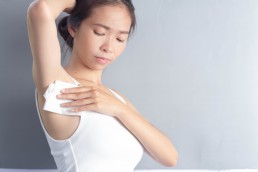Hyperhydrosis (excessive sweating)
Hyperhidrosis is the name given to excessive and uncontrollable sweating. It can be primary or secondary.
Sweat is a weak salt solution produced by the eccrine sweat glands. These are distributed over the entire body but are most numerous on the palms and soles (with about 700 glands per square centimetre)

Primary hyperhidrosis Starts in childhood or adolescence and may persist lifelong or improve with age. There may be a family history and it tends to involve armpits, palms and or soles symmetrically. Usually, sweating reduces at night and disappears during sleep
Primary hyperhidrosis is reported to affect 1–3% of the population and nearly always starts during childhood or adolescence. The tendency may be inherited. Secondary hyperhidrosis is less common and can present at any age.
Primary hyperhidrosis appears to be due to overactivity of the thermoregulatory centre in the brain and is transmitted via the sympathetic nervous system to the eccrine sweat gland.
Triggers to attacks of sweating may include:
- Hot weather
- Exercise
- Fever
- Anxiety
- Spicy food
Secondary hyperhidrosis is less common than primary and more likely to be unilateral and asymmetrical, or generalised. It can occur at night or during sleep, often due to endocrine or neurological conditions or medications.
What are the clinical features of hyperhidrosis?
Hyperhidrosis can be localised or generalised.
- Localised hyperhidrosis affects armpits, palms, soles, face or other sites
- Generalised hyperhidrosis affects most or all of the body
Secondary to other causes excessive sweating can be localised or generalised.
Causes of secondary localised hyperhidrosis include diseases when normal regulation of the sweat glands is impaired:the gustatory hyperhidrosis, stroke, spinal nerve damage,peripheral nerve damage, surgical sympathectomy, neuropathy, a brain tumour, achronic anxiety disorder
Causes of secondary generalised hyperhidrosis include:obesity, diabetes menopause, overactive thyroid, drugs (alcohol, corticosteroids, some antidepressants, opioids), cardio-vascualr disorders, respiratory failure, phaeochromacytoma tumour, Hodgkins lymphoma
What is the impact of excessive sweating?
Hyperhidrosis is embarrassing and interferes with many daily activities.
Axillary hyperhidrosis
- Clothing becomes damp, stained and must be changed several times a day
- Wet skin folds are prone to chafing, irritant dermatitis and infection ( fungal and bacterial)
Palmar hyperhidrosis
- Slippery hands lead to avoidance of handshaking
- Marks left on paper and fabrics
- Difficulty in writing neatly
- Malfunction of electronic equipment such as keypads and trackpads
- Prone to a blistering type of hand dermatitis
Plantar hyperhidrosis
- Affects soles of the feet
- Unpleasant smell
- Ruined footwear
- Prone to a blistering type of dermatitis of soles
- Prone to secondary infection (tinea, pitted keratolysis)
What is the treatment of hyperhidrosis?
General measures
- Wear loose-fitting, stain-resistant, sweat-proof garments.
- Change clothing and footwear when damp.
- Socks containing silver or copper reduce infection and odour.
- Use absorbent insoles in shoes and replace them frequently.
- Use a non-soap cleanser.
- Apply corn starch powder after bathing.
- Avoid caffeinated food and drink.
- Discontinue any medication that may be causing hyperhidrosis.
- Apply antiperspirant.
Topical antiperspirants
- Antiperspirants contain 10–25% aluminium salts to reduce sweating
- Topical anticholinergics such as glycopyrrolate and oxybutynin gel have been successful in reducing sweating; cloths containing glycopyrronium tosylate (Qbrexza)
- Dusting powder is available containing the anticholinergic drug, diphemanil 2%
Iontophoresis
- Is used for hyperhidrosis of palms, soles and armpits.
- Mains and battery-powered units are available.
- The affected area is immersed in water, or, with a more significant effect, glycopyrronium solution.
- A gentle electrical current is passed across the skin surface for 10–20 minutes.
- Repeated daily for several weeks then less frequently as required
- Iontophoresis may cause discomfort, irritation or dermatitis
- The treatment requires a long-term commitment.
- It is not always effective.
Oral medications
Oral anticholinergic drugs
- Available drugs are propantheline 15–30 mg up to three times daily, oxybutynin 2.5–7.5 mg daily, benztropine, glycopyrrolate (unapproved).
- They can cause dry mouth, and less often, blurred vision, constipation, dizziness, palpitations and other side effects.
- People with glaucoma or urinary retention should not take them.
- Caution in older patients: increased risk of side effects is reported, including dementia.
- Oral anticholinergics may interact with other medications.
Beta-blockers
- Beta-blockers block the physical effects of anxiety.
- They may aggravate asthma or symptoms of peripheral vascular disease.
Calcium channel blockers, alpha-adrenergic agonists (clonidine), nonsteroidal anti-inflammatory drugs and anxiolytics may also be useful for some patients.
Botulinum toxin (Botox) injections
- Botulinum toxin injections are approved for hyperhidrosis affecting the armpits.
- The injections reduce or stop sweating for three to six months.
- Botulinum toxins are used off-license for localised hyperhidrosis in other sites such as palms.
Surgical removal of axillary sweat glands
Overactive sweat glands in the armpits may be removed by several methods, usually under local anaesthetic.
- Tumescent liposuction
- Subcutaneous curettage (scraping them out)
- Microwave thermolysis
- Subdermal Nd:YAG laser
- High-intensity micro-focused ultrasound
- Surgery to cut out the sweat gland-bearing skin of the armpits. If a large area needs to be removed, it may be repaired using a skin graft repair
Sympathectomy
Division of the sympathetic spinal nerves by chemical or surgical endoscopic thoracic sympathectomy (ETS) may reduce sweating of face (T2 ganglion) or armpit and hand (T3 or T4 ganglion) but is reserved for the most severely affected individuals due to potential risks and complications.

